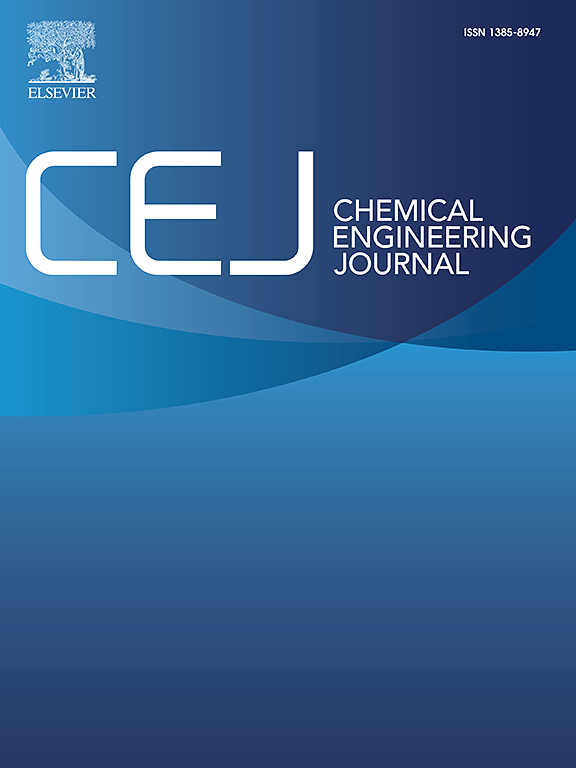增强铁细胞/杯突激活和提高抗肿瘤免疫力的代谢干预策略
IF 13.3
1区 工程技术
Q1 ENGINEERING, CHEMICAL
引用次数: 0
摘要
越来越多的证据表明,纳米铜氧化物能够触发恶性细胞的铜氧化和铁氧化,为癌症治疗提供了可能。然而,如何实现同步的铜氧化和铁氧化敏化仍是一个研究空白。考虑到杯突症和铁突症通路之间的相互作用,操纵它们的共同调控因子提供了一种可行的方法;在此基础上,我们创新性地提出了一种代谢干预策略,以同步增强肿瘤细胞的杯突症/铁突症敏感性。我们利用 STF-31 抑制糖酵解和代偿性烟酰胺腺嘌呤二核苷酸(NAD+)代谢,并将其封装在铜-单宁酸(TA)复合网络/脂质体系统的脂质双分子层中。制备的纳米系统(SCu/L)能显著降低细胞内葡萄糖、NAD+、还原型烟酰胺腺嘌呤二核苷酸磷酸(NADPH)和三磷酸腺苷(ATP)的水平,抑制Cu-ATP酶的活性,从而抑制GSH的合成和Cu的外流,最终强化杯突症和铁突症。此外,糖酵解抑制作用还有助于重塑肿瘤免疫微环境(TIME),最终与免疫原性细胞死亡(ICD)激活的T细胞免疫一起增强抗肿瘤免疫。综上所述,这项研究提出了一种简单而有效的代谢干预策略,可使肿瘤细胞对铜绿系统诱导的铜绿中毒和铁绿中毒同步敏感,为提高铜绿制剂的杀瘤效率和拓展基于铁绿中毒/铜绿中毒疗法的应用前景提供了一种可行的模式。本文章由计算机程序翻译,如有差异,请以英文原文为准。

A metabolic intervention strategy for enhanced ferroptosis/cuproptosis activation and boosted anti-tumor immunity
Accumulating evidence suggests that cupreous nanomaterials are capable to trigger the cuproptosis and ferroptosis of malignant cells, providing possibilities for cancer therapy. However, how to realize synchronous cuproptosis and ferroptosis sensitization remains a research gap. Considering the interplays between cuproptotic and ferroptotic pathways, the manipulation of their common regulators provides a feasible approach; based on this, we innovatively propose a metabolic intervention strategy to synchronously reinforce tumor cells’ cuproptosis/ferroptosis susceptibility. STF-31 is utilized to inhibit glycolysis and compensatory nicotinamide adenine dinucleotide (NAD+) metabolism, which is encapsulated in the lipid bilayers of a composited copper (Cu)-tannic acid (TA) network/liposome system. The as-prepared nanosystem (SCu/L) significantly decreases intracellular glucose, NAD+, reduced nicotinamide adenine dinucleotide phosphate (NADPH) and adenosine triphosphate (ATP) levels and inhibits Cu-ATPase activity, thus inhibiting GSH synthesis and Cu efflux and eventually reinforcing both cuproptosis and ferroptosis. Besides, the glycolysis inhibition effect also helps to remodulate tumor immune microenvironment (TIME), finally boosting anti-tumor immunity together with immunogenic cell death (ICD)-activated T cell immunity. Taken together, this work presents a simple yet effective metabolic intervention strategy for synchronously sensitizing tumor cells to cuproptosis and ferroptosis induced by a cupreous system, providing a feasible pattern for reinforcing the tumoricidal efficiency of cupreous formulations and expanding the prospective applications of ferroptosis/cuproptosis-based therapy.
求助全文
通过发布文献求助,成功后即可免费获取论文全文。
去求助
来源期刊

Chemical Engineering Journal
工程技术-工程:化工
CiteScore
21.70
自引率
9.30%
发文量
6781
审稿时长
2.4 months
期刊介绍:
The Chemical Engineering Journal is an international research journal that invites contributions of original and novel fundamental research. It aims to provide an international platform for presenting original fundamental research, interpretative reviews, and discussions on new developments in chemical engineering. The journal welcomes papers that describe novel theory and its practical application, as well as those that demonstrate the transfer of techniques from other disciplines. It also welcomes reports on carefully conducted experimental work that is soundly interpreted. The main focus of the journal is on original and rigorous research results that have broad significance. The Catalysis section within the Chemical Engineering Journal focuses specifically on Experimental and Theoretical studies in the fields of heterogeneous catalysis, molecular catalysis, and biocatalysis. These studies have industrial impact on various sectors such as chemicals, energy, materials, foods, healthcare, and environmental protection.
 求助内容:
求助内容: 应助结果提醒方式:
应助结果提醒方式:


